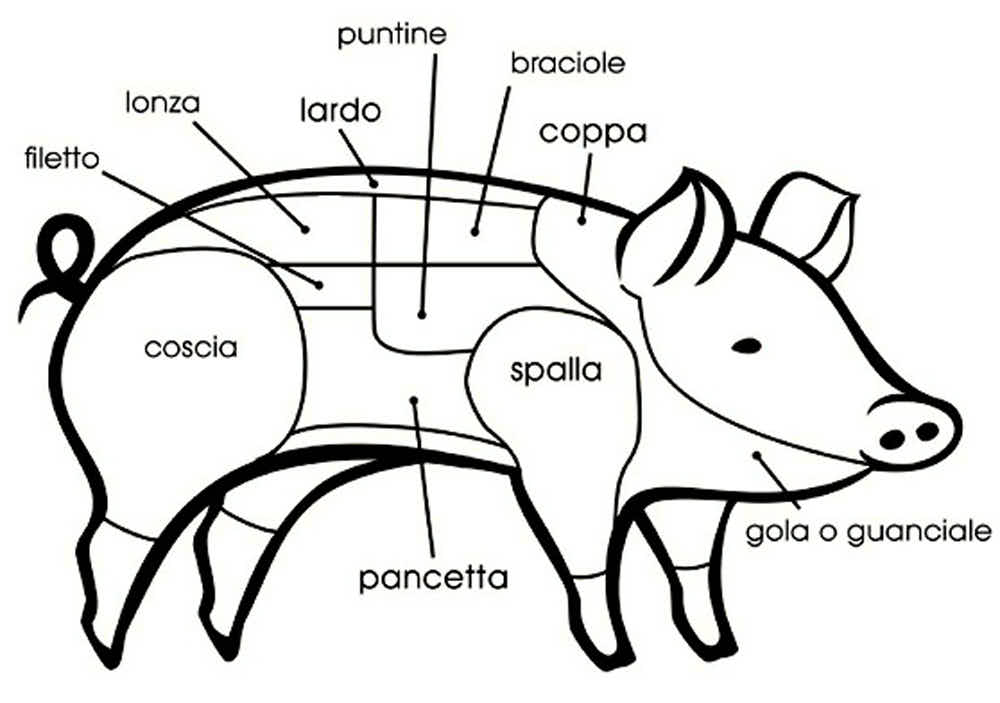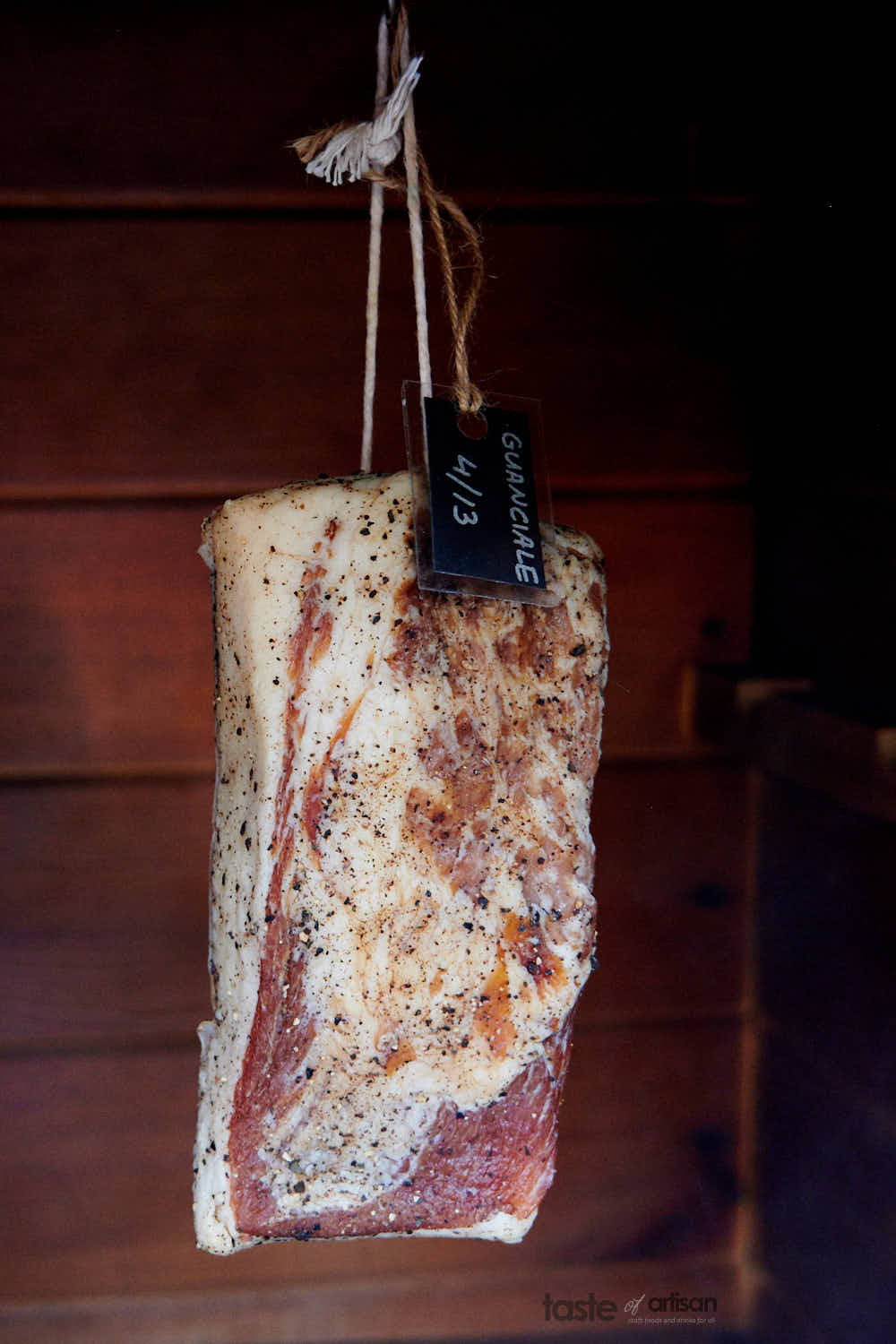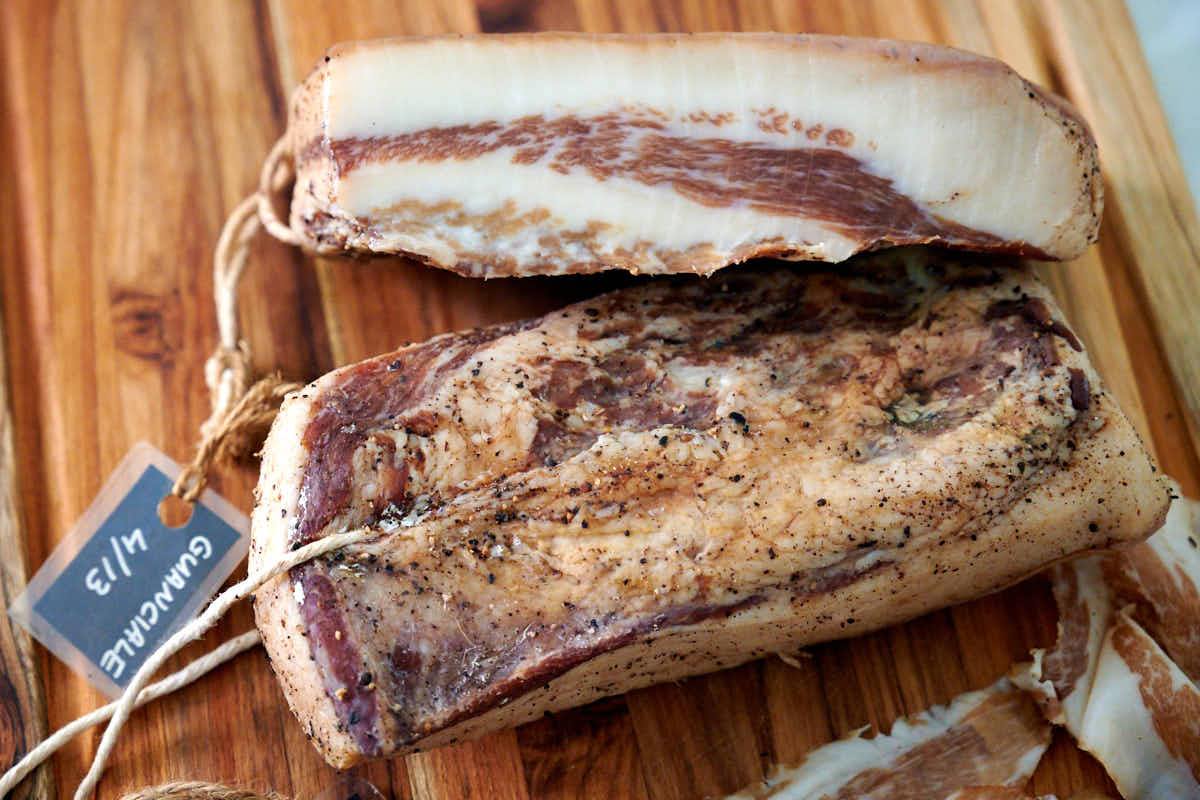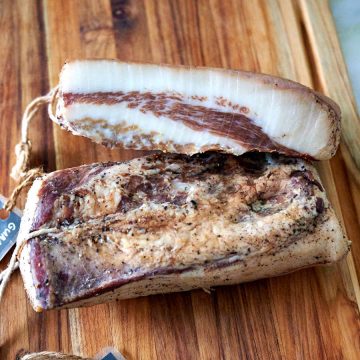Guanciale is a pork cheek that is rubbed with salt and spices, cured, then dried and matured for at least two months. Guanciale is similar in appearance to the pancetta stesa (flat). It can be enjoyed as is, thinly sliced, or a little warmed up and placed on slices of Tuscan-style unsalted bread. Its true destiny, however, is to end up in sauces, especially amatriciana and carbonara. It features a stronger flavor than pancetta, and its texture is more delicate, which gets even better the longer you mature it.

Guanciale is made from the cheek and the throat of a pig. It is salted and cured like pancetta, then matured for two months.

Depending on the region, the type of seasonings used changes. For example, in Lazio aromas of garlic, sage and rosemary are preferred, while in Emilia Romagna they tend to use only salt.
Traditionally, making of guanciale consists of four stages:
- Salting and seasoning where the meat is sprinkled with a mixture of salt and spices, according to a traditional recipe
- Curing in a cold environment to allow salt and aromas to distribute evenly in the meat
- Drying for 5-7 days at 59F - 77F (15C - 25C) and 65%-80%
- Maturing for 2+ months at 50F - 57F (10C - 14C) and 70%-90%
Drying
Traditionally, after salt curing in a cold environment, guanciale would be hung to dry close to a fireplace at about 25-26C for 4-6 hours to bring the temperature up, then moved farther away from the fireplace and dried for about week, ensuring there is sufficient airflow.
Nowadays, with the introduction of temperature and humidity-controlled curing chambers, this task becomes quite easy. Here is the drying schedule that I use for guanciale with great results:
| Stage | Duration | Temp | RH |
|---|---|---|---|
| Warming | 6 hours | 77F (25C) | < 99 % |
| Drying | 18 hours | 73F (23C) | 75-80 % |
| Drying | 24 hours | 71F (22C) | 72-76 % |
| Drying | 24 hours | 68F (20C) | 68-72 % |
| Drying | 24 hours | 64F (18C) | 65-75 % |
| Drying | 24 hours | 61F (16C) | 72-76 % |
| Drying | 24 hours | 59F (15C) | 75-80 % |
The objective of the drying phase is to bring the internal temperature to 77F (25C) to start lactic acid bacteria activity, then gradually drop it to where it will be slowly matured for months. During this time, the humidity will be lowered to ensure optimal water loss.
Smoking
One thing you can do to make your guanciale even better is to smoke it, turning it into guanciale affumicato. Any dish that uses smoked guanciale will be elevated to a whole new level. I find that smoking is best done during drying as the internal temperature of guanciale at that time will be high enough not to cause sweating in the smokehouse. If you try to smoke cold guanciale in a relatively warmer smokehouse, it won't get the color or absorb smoke efficiently. Smoking should be done for a few hours (3-4) over several days.

Maturing
The maturing stage is where guanciale will develop rich, intense flavors and slowly lose additional weight.
Artisan salumi makers prefer to mature guanciale for 60 days minimum and often go as far as 6 months, when they say it acquires stellar taste qualities. How so? Well, salumi rich in fat, especially guanciale, acquire more flavor over time if you let the amino acids and the fatty acids (from the triglycerides of the meat) go through lypolytic and degradative oxidation of unsaturated fatty acids that result in the development of superb aromatic qualities.
I've heard of some artisan salumi makers who choose to mature their salami for close to a year and capicola, guanciale, pancetta, or lardo for up two years or longer. You probably will never find salumi aged that long at a store as it will be financially impractical, but as a home salumi maker, you can create a piece of salumi like that, which will be akin to a 45-year-old bottle of fine single malt whiskey.
Weight loss at different stages
| #1 | Weight | Loss, g | Loss, % |
|---|---|---|---|
| Start | 701 | ||
| End of Drying (7 days) | 636 | 65 | 9.2 % |
| 1 Month | 609 | 92 | 13.1 % |
| 2 Months | 599 | 102 | 14.6 % |
| 3 Months | 596 | 105 | 15.0 % |
| 4 Months | 595 | 106 | 15.1 % |
| 5 Months | 582 | 119 | 16.9% |
| #2 | Weight | Loss, g | Loss, % |
|---|---|---|---|
| Start | 649 | ||
| End of Drying (7 days) | 585 | 64 | 9.7 % |
| 1 Month | 568 | 81 | 12.4 % |
| 2 Months | 554 | 95 | 14.6 % |
| 3 Months | 550 | 99 | 15.3 % |
| 4 Months | 547 | 102 | 15.7 % |
| 5 Months | 536 | 113 | 17.4 % |


Ingredients
- 1000 g pork cheek skin on
- 27.5 g kosher salt 2.75%
- 2.5 g Cure #2 0.25%
- 15 g sugar 1.5%
- 0.5 g whole black pepper 0.05%
- 0.5 g cracked black pepper 0.05%
- 0.4 g cloves 0.04%
- 0.4 g nutmeg 0.04%
Instructions
- Weigh your pork cheecks in grams. Divide by 1000, then multiply each ingredient by that number. For example, if your meat weighs 1650 g, you need to multiply the ingredients specified above by 1.65.
- Mix the salt with the seasonings. Apply the rub evenly all over the pork cheeks. Transfer to a vacuum-sealable bag and seal. You can also use a Ziploc bag.
- Refrigerate for at least 10 days at 3F7-41F (3C-5C).
- Remove the meat from the fridge, blot with paper towels, puncture holes in the upper parts of the cheeks, thread butchers twine through the holes and tie into loops. Weigh each cheek and write down the initial weight on tags.
- Dry at 59F - 77F (15C - 25C) and 65%-86% RH for a period of 6 days as per the drying protocol above.
- After drying, mature at 50F - 57F (10C - 14C) and 70%-90% humidity for at least 2 months.


KJ says
hello Victor
Thanks for sharing your valuable knowledge to the world. Question: during the drying stage, would it be alright to have the temperature at a maximum of 18C instead of 25C? I have a wine cooler that runs max 18C and I would like to avoid stressing the compressor unnecessarily.
Victor @ Taste of Artisan says
Hi KJ, I think you should be fine to stay below the 18C but expect the drying time to be longer. Good luck!
Rafael Pestano says
Hey Victor, thanks a lot for sharing your experience, had great results with Salami and now I'm trying the Guanciale for the first time.
I just have a simple question, in some recipes I see people scrub/clean the seasoning after the cold curing and before the drying phase and then add the crushed black pepper, you're not doing that right? Any specific reason or both methods should work?
Victor @ Taste of Artisan says
Hi Rafael, bith methods will work just fine. I tend to scrub the seasonings off of solid muscles before drying/maturing. Washing off with wine is very common and I do it sometimes, too, with other solid muscles. When seasonings are minimal I just blot with paper towels. Some people have asked me whether they should wash off all the remaning salt, well, there isn't any undissolved salt with this method, so washing isn't needed for that specific reason. Adding more seasonings before drying/maturing is an option, but because guanciale will be smoked, it's a seasoning on its own, I usually don't. I may vary things from batch to batch as I like to experiment, but this is a very good base recipe. Feel free to change things up, it will make things interesting.
Berni says
Hi great article which inspired me to attempt curing my own guanciale.
8 weeks into maturing my first guanciale both cheeks have developed blooms of white mould which doesn’t look healthy.
Initially both pieces rapidly lost roughly 17% of their uncured weight but then after an exceptionally wet October and November both cheeks gained weight before signs of mould appeared.
Any thoughts on how to prevent this happening again?
Victor @ Taste of Artisan says
Hi Berni,
what you describe is normal. White mold is 100% fine and is safe to consume. Of course, I am not saying that you should - you can just wash it off with white wine (or water), or scrape it off. It easily develops at higher humidity levels, I'd say at above 70-72%, so if you keep your humidity down it will solve that problem for you. It's also normal for guanciale to re-absorb some moisture if hiumidity is higher, and I'e experienced that as well. Again, dropping humidity will help with that. So, even thogh a wider range of humidity is allowed for this product, you may want to stay on the lower end of the spectrum and that will alleviate these problems. It's not always possible if you cure other products in the curing chamber that required higher humidity levels, but if that's all you have in there, it's a good option. Good luck.
Berni says
Thank you, that’s reassuring. As it happens I threw them away as I didn’t want to poison anyone but I have another pair of cheeks on the go.
Victor @ Taste of Artisan says
White mold is Penicillium, either Nalgiovense or Salamii, or both. Perfectly safe to eat, but you'd want to remove it as it will impart a bit of own flavor and for aesthetical reasons. Bad stuff is green, blue, black, yellow or pink/red molds. Green mold can be Penicillium which is blooming at high humidity. That one is fine too.
Cathyn says
RH = "relative humidity"? Is that correct?
Victor @ Taste of Artisan says
Yes, that's correct.
mircea says
Hi,
Is there a typo here?
"Maturing for 2+ months at 50F - 57F (10C - 14C) and 70-90F"
Should it be:
"Maturing for 2+ months at 50F - 57F (10C - 14C) and 70%-90%" instead?
Victor @ Taste of Artisan says
Hi Mircea, that is correct, it was a typo. Corrected. Thanks for pointing it out.
SM says
Hi, I'm making Guanciale for the second time, but with a much larger cut. I have an entire 5 pound jowl. I'm curious as to whether I should cure it whole, or break it down into 2 or 3 smaller cuts before the brine. Thanks, and hail to the face bacon.
SM
Victor @ Taste of Artisan says
Love guanciale. Such a treat. Made one in December from half a pig we got, it wasn't too big so I cured it whole.
Regarding your question, a 5-pounder will take a while to mature and get to target weight. Do you want to wait that long? It will be about 8-10 months or longer depending on humidity and your patience. Longer maturation does wonders to pork fat if done properly, but it takes a while. Me, this last December I even split the whole ham to make 3 small culatellos as I wanted them ready sooner.
Tomasz Michałowski says
Wow! You guanciale looks awesome! How did you make it look this good !?
Victor @ Taste of Artisan says
🙂
André GAY says
Bonjour, Ou peut-on acheter de la guanciale?
Combien cela ce vend-il?
Cordialement
Victor @ Taste of Artisan says
André, you seem to be located in France... I think you can buy guanciale in any serious charcuterie store that sells Italian meats and sausages. It's not the most common meat that they sell so it may take some searching.